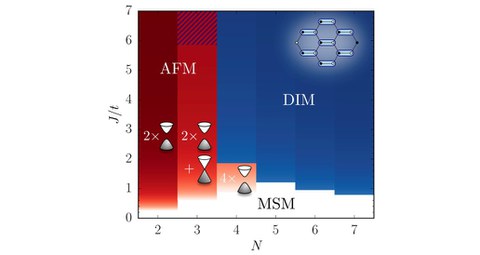24.01.2022
Forschung: Reelles Gegenüber des SU(N)-Hubbard-Heisenberg-Modells entdeckt
What the drosophila is to biomedical science, is the SU(N) Hubbard-Heisenberg model to the theory of strongly interacting electron systems. This model describes a number of strongly-correlated materials and features various phases and phase transitions. Research performed within SFB1143 has now discovered the previously unknown sister of this standard model of theoretical condensed matter physics: The SO(N) Majorana-Hubbard model, in which the complex electrons are replaced by real Majorana fermions. Such a situation may be realizable in topological superconductors or in frustrated spin-orbital magnets.
The phase diagram of the Majorana-Hubbard model exhibits surprising similarities to those of its complex counterpart, with all the main phases that occur in the latter finding their equivalents in the former. It furthermore features a number of interesting quantum phase transitions. These results advance our understanding of the physics of interacting Majorana fermions and the exotic quantum states of matter than can be stabilized in such systems.
L. Janssen, U. F. P. Seifert,
Phase diagrams of SO(N) Majorana-Hubbard models: Dimerization, internal symmetry breaking, and fluctuation-induced first-order transitions,
Phys. Rev. B 105, 045120 (2022) (arXiv)

